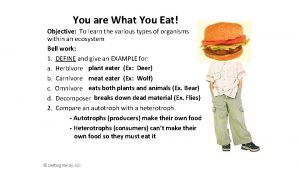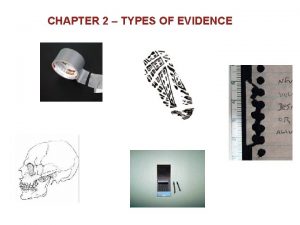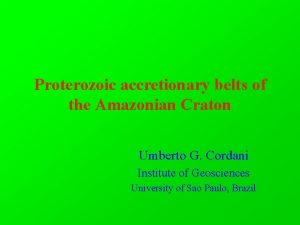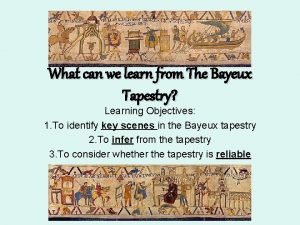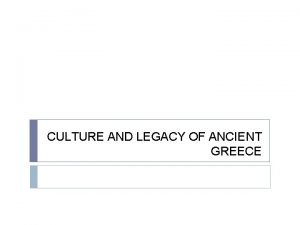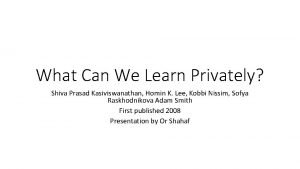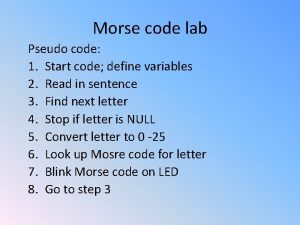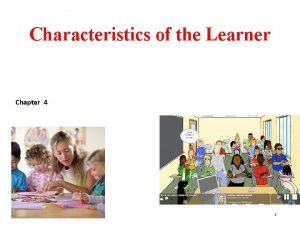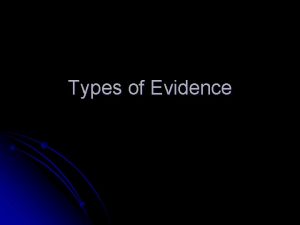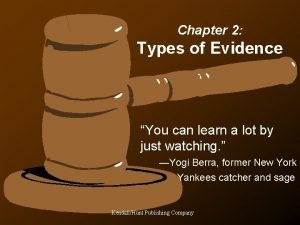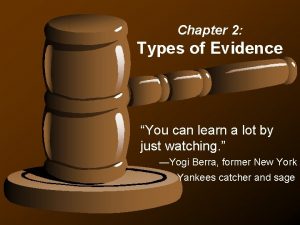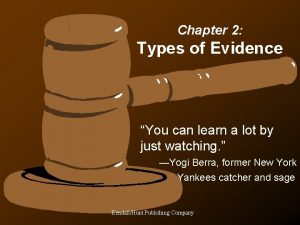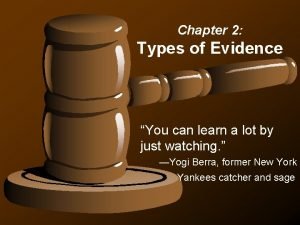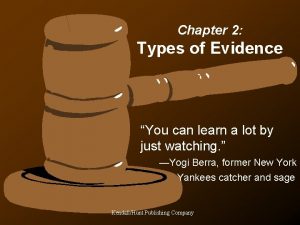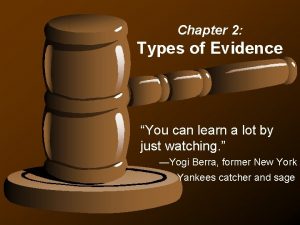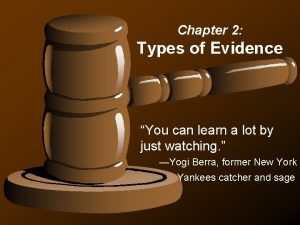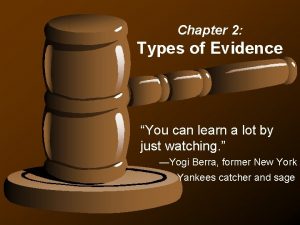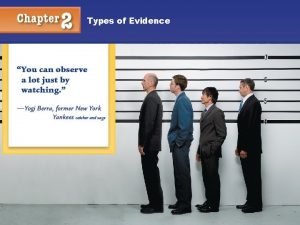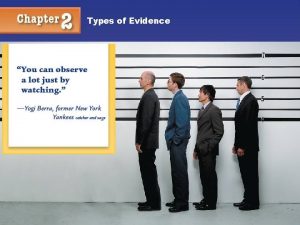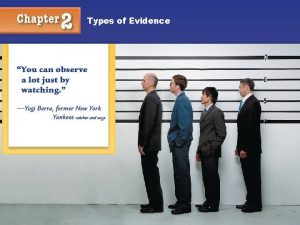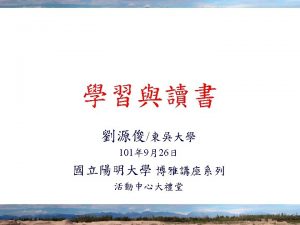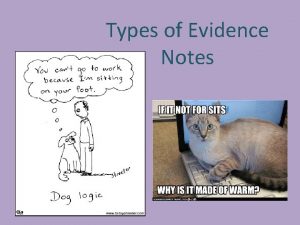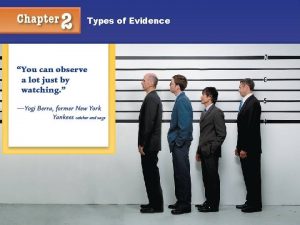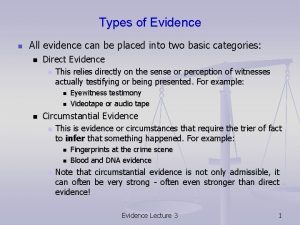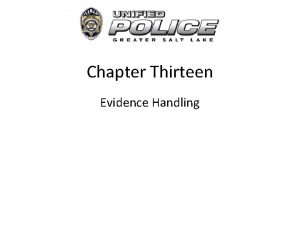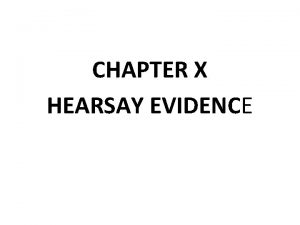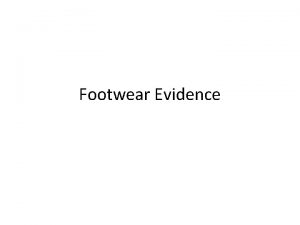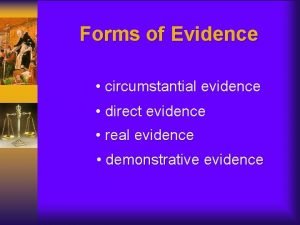Chapter 2 Types of Evidence You can learn


































- Slides: 34

Chapter 2: Types of Evidence “You can learn a lot by just watching. ” —Yogi Berra, former New York Yankees catcher and sage

Evidence Students will learn: § The difference between indirect and direct evidence § That eyewitness accounts have limitations § What is meant by physical evidence and give examples § What physical evidence can and cannot prove in court § The significance of individual and class evidence Chapter 2 Kendall/Hunt Publishing Company 1

Types of Evidence Two general types: § Testimonial—a statement made under oath; also known as direct evidence or Prima Facie evidence § Physical—any object or material that is relevant in a crime; also known as indirect evidence. Examples are hair, fiber, fingerprints, documents, blood, soil, drugs, tool marks, impressions, glass. Chapter 2 Kendall/Hunt Publishing Company 2

Reliability of Eyewitness Factors: § Nature of the offense and the situation in which the crime is observed § Characteristics of the witness § Manner in which the information is retrieved Additional factors: § Witness’s prior relationship with the accused § Length of time between the offense and the identification § Any prior identification or failure to identify the defendant § Any prior identification of a person other than the defendant by the eyewitness Chapter 2 Kendall/Hunt Publishing Company 3

Eyewitness § A police composite may be developed from the witness testimony by a computer program or forensic artist. § “Perception is reality. ” § As a result of the influences in eyewitness memory, physical evidence becomes critical. Chapter 2 Faces—a composite program by Inter. Quest Kendall/Hunt Publishing Company 4

Value of Physical Evidence Louisiana Crime Lab § § Generally more reliable than testimonial Can prove that a crime has been committed Can corroborate or refute testimony Can link a suspect with a victim or with a crime scene § Can establish the identity of persons associated with a crime § Can allow reconstruction of events of a crime Chapter 2 Kendall/Hunt Publishing Company 5

Reconstruction Physical Evidence is used to answer questions about: § § what took place how the victim was killed number of people involved sequence of events A forensic scientist will compare the questioned or unknown sample with a sample of known origin. Chapter 2 Kendall/Hunt Publishing Company 6

Types of Physical Evidence § Transient Evidence—temporary; easily changed or lost; usually observed by the first officer at the scene § Pattern Evidence—produced by direct contact between a person and an object or between two objects § Conditional Evidence—produced by a specific event or action; important in crime scene reconstruction and in determining the set of circumstances or sequence within a particular event § Transfer Evidence—produced by contact between person(s) or object(s), or between person(s) and person(s) § Associative Evidence—items that may associate a victim or suspect with a scene or each other; ie, personal belongings —Lee and Labriola in Famous Cases, 2001 Chapter 2 Kendall/Hunt Publishing Company 7

Examples of Transient Evidence § Odor—putrefaction, perfume, gasoline, urine, burning, explosives, cigarette or cigar smoke § Temperature—surroundings, car hood, coffee, water in a bathtub, cadaver § Imprints and indentations— footprints, teeth marks in perishable foods, tire marks on certain surfaces § Markings Chapter 2 Kendall/Hunt Publishing Company 8

Examples of Pattern Evidence—most are in the form of imprints, indentations, striations, markings, fractures or deposits. § § § Blood spatter Glass fracture Fire burn pattern Furniture position Projectile trajectory Tire marks or skid marks Chapter 2 § Clothing or article distribution § Gun powder residue § Material damage § Body position § Tool marks § Modus operandi Kendall/Hunt Publishing Company 9

Examples of Conditional Evidence § Light—headlight, lighting conditions § Smoke—color, direction of travel, density, odor § Fire—color and direction of the flames, speed of spread, temperature and condition of fire § Location—of injuries or wounds, of bloodstains, of the victim’s vehicle, of weapons or cartridge cases, of broken glass Chapter 2 § Vehicles—doors locked or unlocked, windows opened or closed, radio off or on (station), odometer mileage § Body—position, types of wounds; rigor, livor and algor mortis § Scene—condition of furniture, doors and windows, any disturbance or signs of a struggle Kendall/Hunt Publishing Company 10

Classification of Evidence by Nature § Biological—blood, semen, saliva, sweat, tears, hair, bone, tissues, urine, feces, animal material, insects, bacterial, fungal, botanical § Chemical—fibers, glass, soil, gunpowder, metal, mineral, narcotics, drugs, paper, ink, cosmetics, paint, plastic, lubricants, fertilizer § Physical—fingerprints, footprints, shoe prints, handwriting, firearms, tire marks, tool marks, typewriting § Miscellaneous—laundry marks, voice analysis, polygraph, photography, stress evaluation, psycholinguistic analysis, vehicle identification Chapter 2 Kendall/Hunt Publishing Company 11

Evidence Characteristics § Class—common to a group of objects or persons § Individual—can be identified with a particular person or a single source Fingerprints Chapter 2 Blood DNA Typing Kendall/Hunt Publishing Company 12

Class vs Individual Evidence Which examples do you think could be individual evidence? Chapter 2 Kendall/Hunt Publishing Company 13

Forensic Investigations Include some or all of these seven major activities 1. Recognition—ability to distinguish important evidence from unrelated material § § Pattern recognition Physical property observation Information analysis Field testing 2. Preservation—collection and proper preservation of evidence Chapter 2 Kendall/Hunt Publishing Company 14

Investigations 3. Identification—use of scientific testing § § § Physical properties Chemical properties Morphological (structural) properties Biological properties Immunological properties 4. Comparison—class characteristics are measured against those of known standards or controls; if all measurements are equal, then the two samples may be considered to have come from the same source or origin. Chapter 2 Kendall/Hunt Publishing Company 15

Investigations 5. Individualization—demonstrating that the sample is unique, even among members of the same class 6. Interpretation—gives meaning to all the information 7. Reconstruction—reconstructs the events of the case § § Inductive and deductive logic Statistical data Pattern analysis Results of laboratory analysis —Lee, Dr. Henry. Famous Crimes, 2001 Chapter 2 Kendall/Hunt Publishing Company 16

Class vs Individual Evidence § These fibers are class evidence; there is no way to determine if they came from this garment. § The large piece of glass fits exactly to the bottle; it is individual evidence. Chapter 2 Kendall/Hunt Publishing Company 17

Careers üForensic Scientists üCriminologists üCrime Scene Investigators üCoroners üMedical Examiners üProsecutors Chapter 2 Copyright © Texas Education Agency 2011. All rights reserved. Images and other multimedia content used with permission. 18

Common Duties ü Data collection ü Data analysis ü Data interpretation ü Court testimony Chapter 2 Copyright © Texas Education Agency 2011. All rights reserved. Images and other multimedia content used with permission. 19

Specialized Duties ü Forensic Scientists – identify and/or compare physical evidence through chemical, physical, and instrumental analysis ü Criminologists – study criminal and behavioral psychology to aid in criminal investigations ü Crime Scene Investigators – collect and preserve physical evidence from crime scenes Chapter 2 Copyright © Texas Education Agency 2011. All rights reserved. Images and other multimedia content used with permission. 20

Specialized Duties ü Medical Examiners – perform autopsies to identify the causes and manners of death ü Coroners – typically transport corpses from the crime scene to the morgue; some aid in death investigations ü Prosecutors – initiate arrests, indictments and prosecution of criminals Chapter 2 Copyright © Texas Education Agency 2011. All rights reserved. Images and other multimedia content used with permission. 21

Disciplines ü ü ü ü Trace Evidence (hair, fiber, paint, glass, impressions, etc. ) Latent Prints (fingerprints) Forensic Biology (Serology/DNA) Toxicology (blood alcohol, poisons) Controlled substance (drugs) Questioned documents (handwriting & typescripts) Firearms (firearms and ammunition) Others Chapter 2 Copyright © Texas Education Agency 2011. All rights reserved. Images and other multimedia content used with permission. 22

Other Disciplines ü Crime Scene Investigation ü Forensic Photography ü Forensic Anthropology ü Forensic Computer Science ü Forensic Engineering ü Forensic Entomology ü Forensic Pathology ü Forensic Psychology & Psychiatry Chapter 2 Copyright © Texas Education Agency 2011. All rights reserved. Images and other multimedia content used with permission. 23

Employment Opportunities ü Federal Bureau of Investigation (FBI) ü Federal, State, and Local Crime Laboratories ü Drug Enforcement Administration (DEA) ü Bureau of Alcohol, Tobacco, Firearms, and Explosives (ATF) ü U. S. Postal Service (USPS) ü U. S. Secret Service ü Central Intelligence Agency (CIA) ü U. S. Fish & Wildlife Services ü Teaching at community colleges and universities Chapter 2 Copyright © Texas Education Agency 2011. All rights reserved. Images and other multimedia content used with permission. 24

Employment Qualifications ü Forensic Scientists – Bachelor of Science (BS) or higher in natural or physical science ü Criminologists – BS or higher in sociology or psychology ü Crime Scene Investigators – law enforcement officers with a certification, such as one from the International Association for Identification (IAI) ü Medical Examiners (ME) – licensed pathologists possessing a Doctor of Medicine (MD), that have completed several years of internship in pathology ü Coroners – equivalent to MEs in some jurisdictions; some are elected county officials who handle corpse and death investigation ü Prosecutors – Doctor of Jurisprudence (JD) in criminal law Chapter 2 Copyright © Texas Education Agency 2011. All rights reserved. Images and other multimedia content used with permission. 25

Training ü ü College education Internship In-house training provided by the employing agency External training sponsored by federal and state agencies such as: ü FBI National Academy in Quantico, VA ü Texas Department of Public Safety (TXDPS) ü Workshops provided by various associations during meetings Chapter 2 Copyright © Texas Education Agency 2011. All rights reserved. Images and other multimedia content used with permission. 26

Organizations 4 American Academy of Forensic Sciences (AAFS) 4 American Board of Criminalistics (ABC) 4 Association of Firearm and Tool Mark Examiners (AFTE) 4 More available on the AAFS website: http: //www. aafs. org/forensic-links Chapter 2 Copyright © Texas Education Agency 2011. All rights reserved. Images and other multimedia content used with permission. 27

Certifications & Accreditations 4 American Society of Crime Laboratory Directors – Laboratory Accreditation Board (ASCLD-LAB) 4 Accredits crime laboratories 4 International Organization for Standardization (ISO) 4 Certifies crime laboratories (ISO 17025) 4 American Society for Testing and Materials (ASTM) 4 Certifies testing materials used in analysis 4 American Board of Criminalistics (ABC) 4 Certifies individual forensic scientists Chapter 2 Copyright © Texas Education Agency 2011. All rights reserved. Images and other multimedia content used with permission. 28

Resources 4 American Academy of Forensic Sciences www. aafs. org 4 http: //www. freeresumesamples. org/ 4 Do an Internet search for the following: The CSI Effect Brian Dakss. Chapter 2 Copyright © Texas Education Agency 2011. All rights reserved. Images and other multimedia content used with permission. 29

People in the News Dr. Henry Lee—Chief Emeritus for Scientific Services and the former Commissioner of Public Safety for the state of Connecticut. He served as that state’s Chief Criminality from 1979 to 2000. Lee was the driving force in establishing the modern forensic lab in Connecticut. He has worked with many high profile cases including O. J. Simpson, Jon Benet Ramsey, and the “wood chipper” case. He is also seen on many of the true crime shows, including his own, “Trace Evidence: The Case Files of Dr. Henry Lee”. Learn more at his website: www. drhenrylee. com/review. shtml Chapter 2 Kendall/Hunt Publishing Company 30

Case Study Pg 24 4 Coral Eugene Watts 4 Part one 4 Part two 4 Part three Chapter 2 Kendall/Hunt Publishing Company 31

FBI Investigation Read a case investigated by the FBI. Observe the various units of their lab and read the section: “How They Do That? ”. www. fbi. gov/kids/6 th 12 th/investigates. htm Chapter 2 Kendall/Hunt Publishing Company 32

PBS- Forensics 453 minutes Chapter 2 Kendall/Hunt Publishing Company 33
 If you think you can you can poem
If you think you can you can poem Fiber evidence can have probative value
Fiber evidence can have probative value Kinesthetic learning
Kinesthetic learning Lesson from the ants
Lesson from the ants If you can imagine it you can achieve it
If you can imagine it you can achieve it You are what you measure quote
You are what you measure quote If you can't measure it you can't manage it
If you can't measure it you can't manage it If you can't measure it you cannot improve it
If you can't measure it you cannot improve it Vertikale kennzahlen
Vertikale kennzahlen The more you study the more you learn
The more you study the more you learn You live to learn
You live to learn You are what you learn
You are what you learn What is primary sources
What is primary sources Primary evidence vs secondary evidence
Primary evidence vs secondary evidence Primary evidence vs secondary evidence
Primary evidence vs secondary evidence Primary evidence vs secondary evidence
Primary evidence vs secondary evidence Primary evidence vs secondary evidence
Primary evidence vs secondary evidence Class vs individual evidence
Class vs individual evidence Difference between testimonial and physical evidence
Difference between testimonial and physical evidence Class vs individual evidence
Class vs individual evidence The absence of evidence is not evidence of absence meaning
The absence of evidence is not evidence of absence meaning Transient evidence examples
Transient evidence examples What can we learn from the woopmay orogeny?
What can we learn from the woopmay orogeny? What can we learn from the passage
What can we learn from the passage Make your own bayeux tapestry
Make your own bayeux tapestry Culture and legacy of ancient greece stations
Culture and legacy of ancient greece stations All children can learn slogan
All children can learn slogan Shiva prasad kasiviswanathan
Shiva prasad kasiviswanathan What can we learn from india
What can we learn from india Morse2ascii
Morse2ascii You can tell harris about it just ____(easily) as i can
You can tell harris about it just ____(easily) as i can You can tell harris about it just ____(easily) as i can
You can tell harris about it just ____(easily) as i can How to be more impressive 1+1=2
How to be more impressive 1+1=2 Through you i can do anything i can do all things
Through you i can do anything i can do all things Knowledge readiness
Knowledge readiness











